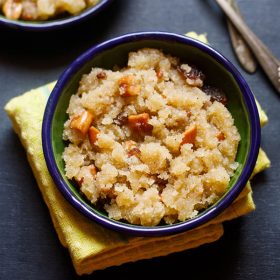Suji Ka Halwa | Sheera Recipe
Suji Ka Halwa (also called Sheera) is a classic Indian semolina pudding made with roasted suji (rava/semolina), ghee, sugar, and cardamom, garnished with nuts. This melt-in-the-mouth North Indian sweet is my family’s heirloom recipe; made for decades during festivals, poojas, and special occasions. Quick to prepare and easily scalable, this halwa is perfect as prasad or a comforting dessert any time.
Servings: 4
Calories: 344kcal
Ingredients
- ½ cup suji (fine rava or semolina or cream of wheat)
- ⅓ cup sugar or approximate 5 to 6 tablespoons sugar or add as required
- ⅓ cup ghee - approximate 6 tablespoons of ghee
- ½ teaspoon cardamom powder - or 4 to 5 green cardamoms powdered in a mortar-pestle, husks discarded
- 10 to 12 cashews - halved or whole (kaju)
- 2 tablespoons golden raisins (kishmish)
- 1 teaspoon chironji - optional (charoli)
- 1.25 cups water - can also add 1 cup water
- 1 pinch edible camphor - optional
Instructions
Preparation
- Crush the green cardamom seeds to a fine powder in a mortar-pestle and keep aside. Remove the husks
- Keep a kadai or pan on a low flame.
- Add the ghee and when the ghee is heating up, do the following.
- Take the sugar and water in another pan.
- Keep this pan on a medium to high heat and let the sugar syrup come to a boil.
- Once the ghee becomes hot, add the suji (semolina) and cashews and stir.
- Keep on stirring the suji (semolina) so that the grains does not stick to the pan and are roasted evenly.
- Meanwhile keep your attention on the sugar syrup also.
- If the mixture starts to boil, then lower the heat and let it simmer.
- Keep on roasting and stirring the semolina for 7 to 8 minutes till the grains change their color and when the cashews also change to a light golden or golden.
- You have to roast sooji till you can see the ghee getting separated. The color of the suji or rava should not become brown. There will also be a fragrant aroma of suji and ghee in your kitchen.
- Remember that the roasting rava is very important. If the rava not is not roasted well then you won't get the best texture in the halwa and there will be slightly raw taste.
- Then add the cardamom powder, chironji, raisins and edible camphor (optional). Mix very well.
Making suji ka halwa or sheera
- Stir and then add the bubbling hot sugar syrup slowly to the roasted suji mixture.
- Be careful as the mixture has the tendency to splutter.
- Be quick enough to stir. The sooji will begin to absorb the water and swell.
- Keep on stirring often till the whole mixture starts thickening and starts to leave the edges of the kadai or pan.
- Serve sooji halwa hot or warm or when cooled at room temperature.
Serving & Storage
- It can be had as a sweet snack or served as a dessert after meals.
- Store any leftovers in the fridge in an air tight container for 1 to 2 days.
- Reheat in a pan before serving. If the mixture has thickened or set, add a splash of water or milk to loosen it. Reheat gently, as overheating may cause the ghee to separate. Stir well before serving.
Video
Notes
- Type of suji: Use the fine variety of suji for making halwa. Ensure that your rava is fresh, within its shelf period and does not have insects or mold and is not rancid.
- Edible camphor: Add a pinch of edible camphor if you are making suji halwa for religious occasions.
- Temperature: When adding the sugar syrup to the rava, it has to be boiling and bubbling hot. If the sugar syrup becomes warm, then heat it up till it comes to a boil. The roasted rava mixture also has to be hot when the sugar syrup is added.
- Multi-cooking: When you begin roasting the rava, at the same time, keep the sugar syrup to boil on another burner.
- Adding less amounts: You can reduce both the amount of sugar and ghee. For less sweet taste in rava sheera, add ¼ cup sugar.
- Sweetener: Jaggery can be also added instead of sugar. First, add jaggery in water and heat the water till it becomes warm. When all the jaggery is dissolved, strain the syrup to get rid of impurities. Put the strained syrup back in the pan and heat till it comes to a boil.
- Liquids: You can add milk instead of water.
- Flavorings & Nuts: You can add your choice of dry fruits and nuts. For flavoring and aroma apart from cardamom powder you can also add saffron strands or even rose water.
- Scaling: Recipe can be halved or doubled or tripled.
Nutrition
Calories: 344kcal | Carbohydrates: 40g | Protein: 4g | Fat: 20g | Saturated Fat: 11g | Polyunsaturated Fat: 1g | Monounsaturated Fat: 5g | Cholesterol: 44mg | Sodium: 32mg | Potassium: 115mg | Fiber: 48g | Sugar: 21g | Vitamin A: 11IU | Vitamin B1 (Thiamine): 1mg | Vitamin B2 (Riboflavin): 1mg | Vitamin B3 (Niacin): 3mg | Vitamin B6: 1mg | Vitamin C: 1mg | Vitamin E: 1mg | Vitamin K: 1µg | Calcium: 161mg | Vitamin B9 (Folate): 26µg | Iron: 8mg | Magnesium: 23mg | Phosphorus: 151mg | Zinc: 1mg
